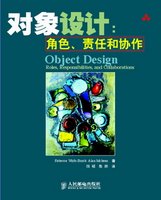Translating Object Design
Recently I received a copy of the Chinese translation of my book, Object Design: Roles, Responsibilties and Collaborations. It took nearly three years to translate. I hope it sells well, although authors only get a mere pittance for selling translation rights (think $100 or less--and I have to split that with my co-author). So I won’t be making money even if becomes a best seller in China. Creating and marketing a best selling book can be dicey as this interesting blog posting for someone in the book publishing business points out (I didn’t write this book to retire on, I wrote it to get the word out about role-based object design).

I found it fascinating to compare the English with the Chinese edition. As I thumbed through the book several features were missing that we thought essential when we originally worked with our editor (in hindsight, our requests added to the book’s cost, but probably made little difference in how well it has sold). We convinced our editor to produce a two-color book so we could annotate drawings using blue. The editors then figured out ways to incorporate blue into subsection titles, boxed in examples, etc. The Chinese edition was black and white and had no index. Margin comments had been boxed off and inserted along with the main text. That certainly made formatting a lot easier.
It was interesting to see the text sprinkled with English words and pseudo-English class names: e.g. Rebecca Wirfs-Brock, Brian Wilkerson, Rational Unified Process, Kay, GuessingLettersOnly, aMessageBuilder, Michael Jackson (the UK problem frames inventor, not THE singer). The format of the Chinese edition numbered subsections, where in the English language version we did not. On the cover, our names were in a smaller font than the text, forewards by Ivar Jacobson and John Vlissides. I’m guessing this was to sell more books. The cover included the same cover art but the lettering and colors were much simpler. On the cover, the book’s title was in both Chinese and English. The paper is thin decreasing the thickness of the book by 50%. Printing quality wasn’t great. The translated book was 313 pages vs. 390 for the English version. I wonder whether Chinese writing is more compact or whether parts have been omitted. It is hard to tell.
I’m meeting with one of the translators of our book to Japanese at next week’s Architecture and Design World. I really look forward to meeting him in person. Translators who take their job seriously ponder words and meanings. And because of the differences of words in different languages, they can uncover nuances than I ever thought about. For example, I received this query from the Japanese translator about this sentence from our book: "As we conceive our design, we must constantly consider each object’s value to its immediate neighborhood." He asked, "Does the meaning of neighborhood in your book correspond to the definition ’objects who live near one another’ or ’in a particular district or area’? If your answer is yes, could you make selection between ’live near one another’ or ’in a particular district or area’ because we have different Japanese words for each."
One of my favorite books is Douglas Hofstadter’s Le Ton Beau De Marot: In Praise of the Music of Language. This book is all about the nuances of translation. Hofstadter, who also wrote the best-selling Gödel, Escher, Bach: An Eternal Golden Braid, explores the myriad constraints that must be chosen to be relaxed (or tightened) when translating, as well as the choices the translator makes to preserve the original author’s context or to translate it to a more familiar one of the reader. As a vehicle to explore these ideas, he used a 500 year old French poem that he gave to many friends and colleagues to translate (and he, himself wrote dozens of translations). It’s fascinating reading. As a designer and requirements analyst, I often find myself discriminating very fine shades of meaning. There’s nothing straightforward or mechanical about this process. But to me, translating poetry seems much more challenging. And translators of technical books deserve credit and recognition for their own contributions.
- Previous: Pay by the job, or pay as you go?
- Next: But Joe says....